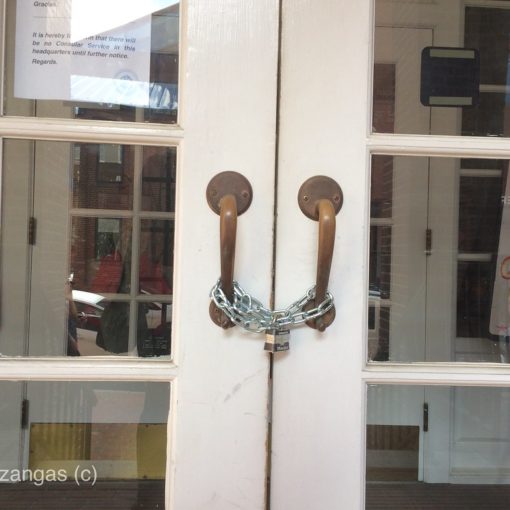by Anne Meador
Opponents of the fossil fuel extraction process called hydraulic fracturing rallied on January 8 at the Murphy Court of Appeals in Annapolis, MD, as oral arguments were presented in a lawsuit concerning the proposed expansion of the Cove Point Liquid Natural Gas (LNG) terminal.
They also appealed to state legislators on the first day of the General Assembly session to prevent the fracking industry from coming to Maryland.
In court, Dominion Resources, owner of the Cove Point LNG facility in Calvert County, fought to uphold a lower court ruling against environmental organization Sierra Club. Dominion is disputing the Cove Point Natural Heritage Trust, a 35-year-old agreement which gives Sierra Club authority to mitigate the impacts of any changes to the facility.
“What this comes down to at the end of the day is something really simple: Does this settlement give us the right to veto this project?” said Josh Tulkin, director of the Maryland chapter of Sierra Club. [Video interview]
The settlement was last updated in 2005 when a new offshore pier was proposed. Tulkin says “acceptable use” was then further spelled out to define import of LNG as “receipt by tanker” to the offshore pier. Dominion, he says, is trying to convince the court to interpret the clause as delivery from land by tanker to the pier, where it could then be exported to Asia.
“It was clearly not the original intent [of the agreement],” Tulkin said.
The judge will deliver a ruling on the appeal no sooner than April.
Meanwhile, Dominion Resources’ push to expand the Cove Point terminal to become a major export facility for “fracked” gas has become a flashpoint for controversy. Maryland residents have stepped in to stop the $3.8 billion project, contending that an export operation and its supporting infrastructure will adversely affect the economy, environment and citizens’ health, while opening up Maryland to a fuel extraction method still being developed by trial and error. Dominion, on the other hand, claims that residents’ fears are unfounded and the state’s economy will benefit.
On the first day of the state’s legislative session, about fifty opponents to the Cove Point LNG terminal and fracking in Maryland expressed their fear and outrage at Lawyer’s Plaza in Annapolis.
A Community’s Concerns
The Cove Point Lighthouse just south of the LNG terminal is located on a piece of land jutting out from the Western Shore into the Chesapeake Bay. Sue Allison describes the surrounding neighborhood of Cove Point as her family’s “dream community.” With the proposed expansion of the LNG terminal, she fears that it will become “just another gas industry sacrifice zone.”
The massive construction project will have significant impacts on Lusby and Solomons Island, sandwiched between the Chesapeake Bay and the Patuxent River. It will include a utility scale gas turbine power plant and a 60-foot-high sound abatement wall spanning three-quarters of a mile. Among other things, the sole highway along the peninsula of Southern Maryland will be clogged with traffic. But her concerns lie with plummeting real estate values and “pollution trading schemes.”
Eleanor Callahan, another Cove Point resident, explains that pollution is already bad in the area, and the expansion will make it even worse. “If the Dominion LNG project goes through, the plant alone will make Calvert County the seventh highest greenhouse gas emission county in the country,” she said.
They feel that County Commissioners have shrugged off their concerns, referring them to Dominion to be “educated.” Callahan said that at the board meeting in November, Commissioners told residents, “We can’t do anything for you.”
Shale Gas “Gold” Buried Beneath Maryland
Maryland is one of few states with gas basins untouched by fracking. Callahan is sure that the Cove Point expansion will open up Maryland to the fracking industry. “A USGS survey shows that the greatest gas and oil quantities are to be found right under the Chesapeake Bay from the Western Shore to the Eastern Shore and beyond,” she said. “This is gold buried beneath the Bay that greedy giants want to get by fracking.”
State delegate and gubernatorial candidate Heather Mizeur is Maryland’s only elected official to oppose the Cove Point project. She addressed the crowd at Lawyer’s Plaza. “Every other state drills first, asks questions later to disastrous consequences,” she said. “Do we want flammable water in Maryland? Do we want our communities suffering because of the environmental and public health risks from the dangers of fracking?” Mizeur is introducing a bill this session that would put a moratorium on fracking for eighteen months.
Fracking Comes with Baggage
“Fracking will bring more pipes, more methane, domino effects. It just produces more and more,” said Callahan.
Dominion Resources is getting infrastructure in place to transport fracked gas to Cove Point. A 16,000-horsepower compressor in Myersville, MD is part of that plan. Ann Nau of Myersville says it would produce massive amounts of polluting gases less than a mile from the elementary school in her town.
“So when our representatives are considering the impacts of fracking, they must address indirect and cumulative impacts of shale gas development, including related infrastructure and the buildup from that,” she said.
Potential Health Hazards
Gina Angiola, a retired physician, warned of dangerous health hazards associated with fracking by chemicals leeching into the soil and water system and pollutants emitted into the air. Chemicals used in fracking, she said, are known carcinogens, neurotoxins, and endocrine disruptors.
“We are all engaged in one of the biggest public health experiments that’s ever been put before us. Nobody wants to put it in these terms, but we are the lab rats,” Angiola said.
Knowing the Risks
Dominion conducted an Environmental Assessment (EA), but environmental groups and community advocates say that’s not enough. They want a Environmental Impact Study (EIS) encompassing both the facility and the supporting infrastructure to assess the risks fully. On January 8, Maryland Attorney General Doug Gansler joined them in calling on the Federal Energy Regulatory Commission (FERC) to conduct an EIS.
The Cove Point LNG terminal is now at the center of a high-stakes battle for Maryland’s energy future. “We are at a crossroads,” said Mike Tidwell of Chesapeake Climate Action Network. “We can either continue with wind and solar development that we’ve begun to do, or we can get thrown off course by Dominion and get involved in one of the dirtiest fossil fuel projects ever proposed in our state.”
- Maryland delegate Heather Mizeur
- EarthJustice attorney Jocelyn D’Ambrosio
- Mike Tidwell of Cheapeake Climate Action Network
Video highlights of rally in Annapolis:
Interview with Josh Tulkin, director of the Maryland chapter of Sierra Club:

















